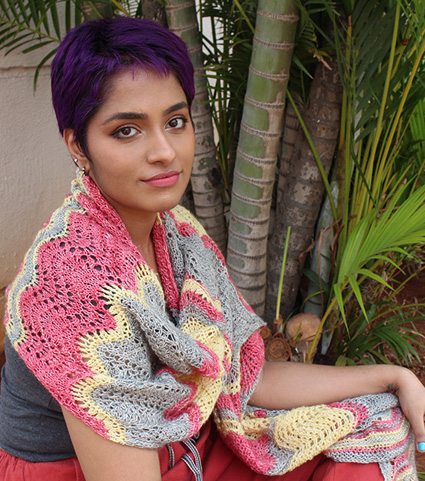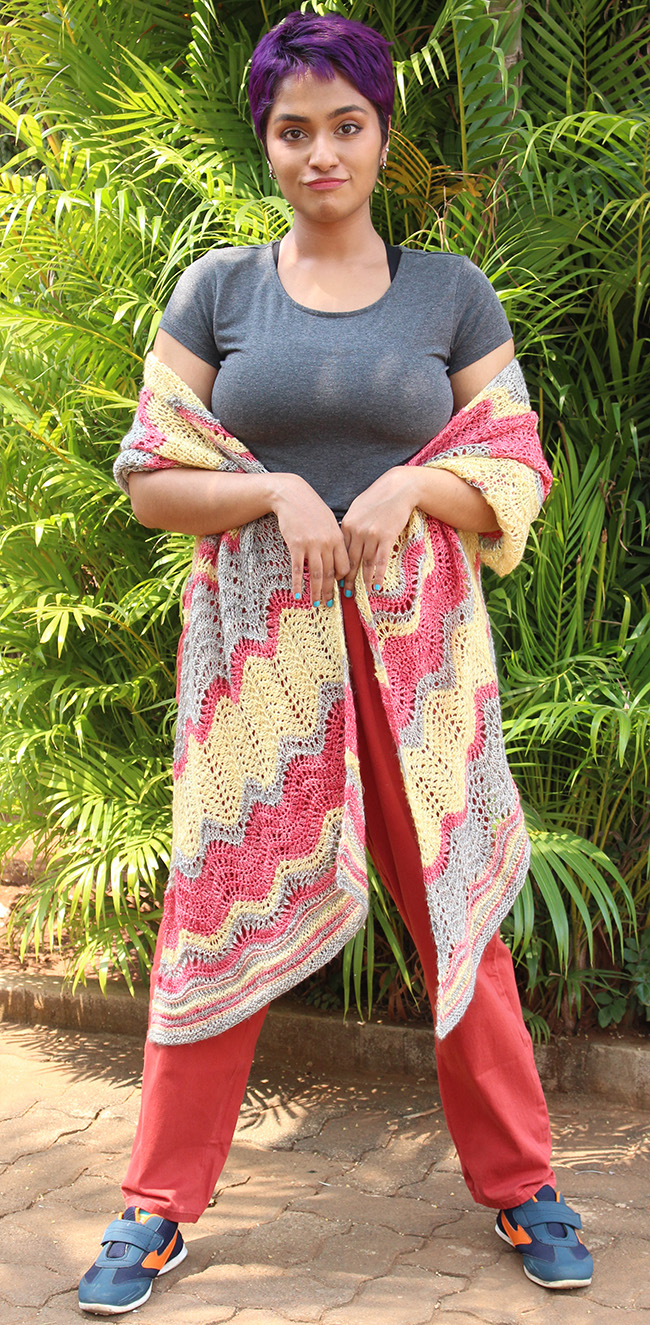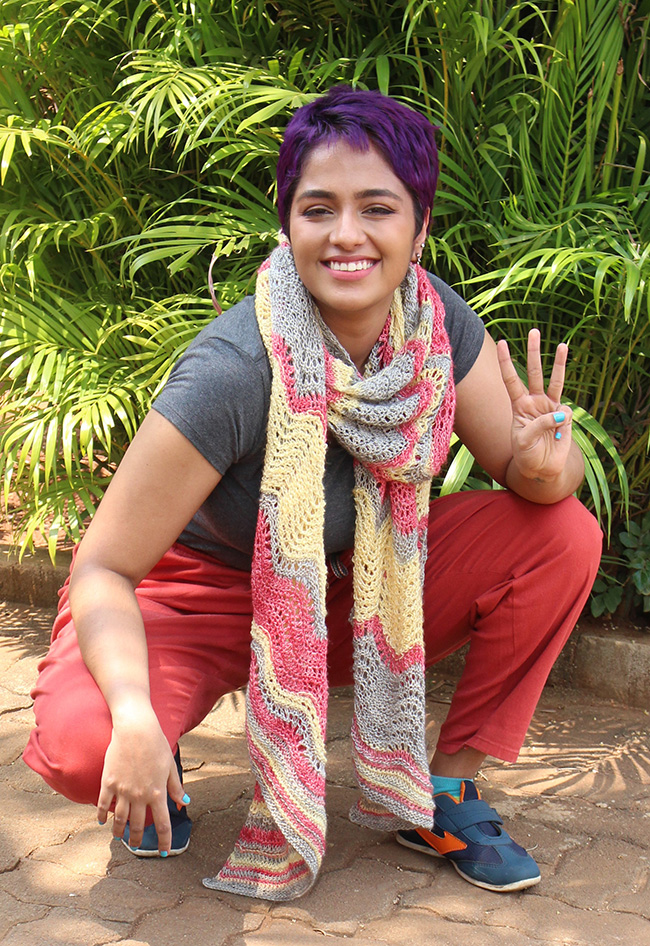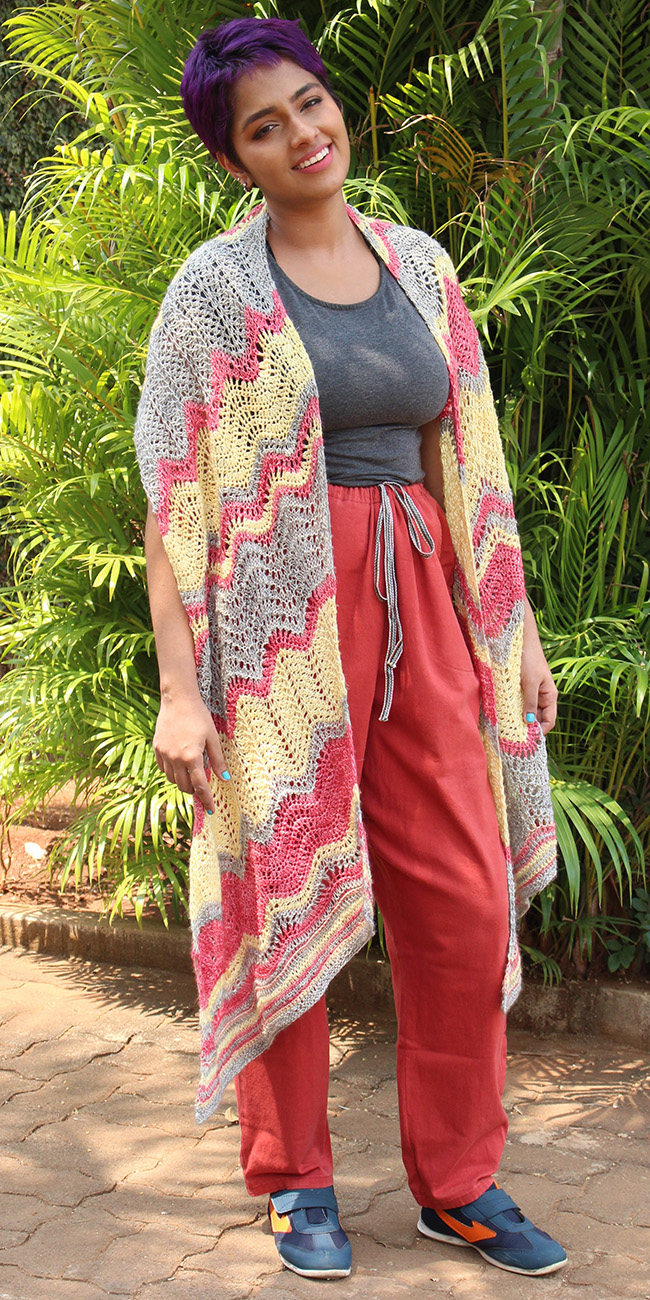Trinary, a free pattern from Knitty.com. Free knitting, crochet and tunisian crochet pattern for a colorblocked lace shawl.
INTRODUCTION
Trinary
 by Padma R
by Padma R
![]()
Trinary is a joyful celebration of three crafts and their interplay in lace.
In this unusual stole, a lace ripple flows gracefully through knit, crochet and Tunisian crochet. Stripes at the short edges and bias shaping add zing and flair, but are deceptively easy to work. Each section of the stole body looks subtly and intriguingly different from the one before, although the stitches are the same; this is achieved by simply changing the yarn color for a particular technique.
My inspiration for this design comes interestingly, from Knitty itself. Looking at the Knitty webpage one day, my eye fell on a little box containing the words "knit + crochet". I was reminded that I've always wanted to design in lace using both knit and crochet. Then, I thought it might be exciting to add Tunisian to the mix! The idea became a bit of an obsession when I did a search on Ravelry and discovered that as on date, there is no published single pattern that incorporates all three crafts in a lace fabric. Trinary is the result of my adventure.
The pattern has been written and charted to be easily approachable and uses just a couple of stitches from each craft. Whether you're a knitter who knows just to sc and dc or a crocheter or TC-er who knows just to knit and purl, this project is fun. Wrong side rows have no patterning or shaping (except for one stripe row) and the pattern repeat is easily remembered, making it a relaxing project.
 model: Amrita R
model: Amrita R
 photos: Padma R
photos: Padma R
SIZE
One size (adjustable)
FINISHED MEASUREMENTS
Width: 16 inches/40.5cm, measured straight across
Length: 82 inches/208cm
MATERIALS
Yarn
Eden Cottage Yarns Keld Fingering [90% Merino, 10% Linen/Flax; 394yds/360m per 100g skein]
![]() [A] Ash; 1 skein
[A] Ash; 1 skein
![]() [B] Dianthus; 1 skein
[B] Dianthus; 1 skein
![]() [C] Daffodil; 1 skein
[C] Daffodil; 1 skein
Yarn Characteristics
Keld Fingering is a blend of superwash merino and linen which has both softness and excellent stitch definition. It is a slightly uneven yarn with linen fibers providing a little fluff and texture. A solid or nearly-solid color is most effective to show off the pattern stitches and texture.
[always use a needle size that gives you the gauge listed below - every knitter's gauge is unique]
Notions
![]() ring stitch markers (for knitting)
ring stitch markers (for knitting)
![]() locking stitch markers (for crochet and Tunisian crochet)
locking stitch markers (for crochet and Tunisian crochet)
![]() yarn needle
yarn needle

GAUGE
18 sts/24 rows = 4 inches/10 cm in Knit pattern.
12 sts/19 rows = 4 inches/10 cm in Crochet pattern.
20 sts/20 rows = 4 inches/10 cm in Tunisian crochet pattern.
Note: measure gauge after blocking and relaxing. Gauge is not critical but will affect finished size.
To work a gauge swatch: work 2 repeats of Body pattern (marked in bold in instructions) with edge sts (40 sts) and without increase and decrease sections, repeating the following rows for about 4 inches height, making separate swatches for knit, crochet and TC:
- Knit pattern: Rows 1-4
- Crochet pattern: Rows 25-26
- TC pattern: Rows 27-28.
PATTERN NOTES
[Knitty's list of standard abbreviations and techniques can be found here.]
Editor's note: There's a lot to read here, but it's all really important. Please do go through this before beginning the pattern.
Stitch markers are helpful to separate increase and decrease sections from pattern repeats, to mark off repeats and to keep correct stitch count. Move markers upwards into the next row as you work it.
- Knit: use ring markers as desired between right edge sts, increase section, pattern repeats, decrease section and left edge sts.
- Crochet: place locking stitch markers in top ch of first edge st, the first sts of the increase section, each pattern repeat and decrease section respectively, and in last st of decrease section.
- Tunisian Crochet: place locking stitch markers in the first sts of the increase section, each pattern repeat and decrease section respectively, in last st of decrease section and in left edge st The last 2 markers help in easy stitch identification on the next row.
Carrying yarns up the right edge:
- Where feasible, carry yarns by twisting working yarn and unused yarn before working the second or third stitch of the row. If carrying two colors, twist them separately for less bulk.
- The knit sections of the fabric are too lacy for unobtrusive carrying of unused colors, so I recommend cutting the yarn if you're not going to use it again for at least another 3 or 4 rows.
- If carrying 2 colours, twist one before the second stitch and the other before the third stitch to reduce bulk.
To Adjust or Customize:
- Size is adjustable from scarf to stole to large wrap, by changing the number of pattern repeats.
- After the cast-on row, you can start (or end) the piece with any row you like.
- Short edges may be blocked straight as shown or pulled into gentle waves if preferred.
- If you prefer deeper scallops on the short edges, omit the striped sections.
- For a straight shape, omit the bias shaping (increase and decrease sections).
- The stole shown uses three colors but you can use just one – or as many as you wish.
- This pattern is perfect for stash and scrap yarn busting! Line up your fingering-weight yarns in a pleasing color progression; as long as you have enough of a color for a single row, the pattern will work – and you'll end up with a truly original piece.
NOTES ON WORKING FROM CHARTS
- CHART NUMBERS AND COLORS
- Odd-numbered rows are RS rows and even-numbered rows are WS rows (except for RetP rows in TC which are even-numbered but are worked on RS).
- All RS rows begin with an increase and end with a decrease. All WS rows are worked even (with no increase/decrease) except for Row 19 of the Starting Section which is worked on the WS, and begins with a decrease and ends with an increase.
- Colors are shown for Starting and Ending charts, but not for Body chart. Consult the instructions in the pattern – the Body chart is worked 4 times total, with different colors each time.
- For the Body chart, work the stitches in the red-bordered area 4 times.
- KNIT SECTIONS
- The first knit row after a Crochet or Tunisian crochet row is shown as a standard knit row on the charts, for simplicity. You will actually pick up and knit stiches, as outlined in Special Stitches below.
SPECIAL STITCHES
- KNIT
- M1: use the backwards loop method.
- Picking up knit stitches from a crochet row: On the crochet row, the last sc on WS is completed by pulling new color through the last two loops (one loop of new yarn on hook). Transfer loop from hook to right needle (this is the first edge stitch). Working from right to left across the row, insert needle under both loops of the sc, wrap yarn around knitwise and pull through to make a stitch.
- Picking up knit stitches from a Tunisian crochet row: On the RetP row, the last st is completed by yarn over and pulling new color through the last two loops (one loop on hook). Transfer loop from Tunisian hook to needle (this is the first edge stitch). Working from right to left across the row, insert needle under front loop of each vertical bar, wrap yarn around knitwise and pull through to make a stitch.
- CROCHET
- Ch1: Chain one. This counts as 1 sc (first st) throughout; pm in ch1 for easy identification. If working into a crochet row, sk st directly below and work sc from second st onwards. If working into a knit or Tunisian crochet row, work into next st as usual.
- Ch2: Chain two. This counts as 1 dc (first st) throughout; pm in top of ch2 for easy identification. If working into a crochet row, sk st directly below and work dc from second st onwards. If working into a knit or Tunisian crochet row, work into next st as usual.
- 2sc-in-1: Work 2 sc into indicated stitch. One stitch increased.
- sc2tog: Single crochet 2 together. Insert hook into next 2 sts together, pull up a loop, yo and pull through 2 loops. One stitch decreased.
- 2dc-in-1: Work 2 dc into indicated stitch. One stitch increased.
- dc2tog: Double crochet 2 together. With one loop on hook, yo, insert hook into next 2 sts together, pull up a loop, [yo and pull through 2 loops] twice. One stitch decreased.
- Working crochet stitches into a knit row: If attaching a new color, place a slipknot of new yarn on hook. Insert hook from left to right into first edge st, pull a loop through stitch and slipknot to secure. If using a carried color, insert hook from left to right into first edge st, and pull up a loop. Next, work ch1 or ch2 as instructed. Drop worked st from needle. Continue to end of row in pattern. To work sc: insert hook from left to right into a knit st, pull a loop through stitch, yarn over and pull through 2 loops. To work hdc: yarn over, insert hook from left to right into a knit st, pull a loop through stitch, yarn over and pull through 3 loops.Tip: it is easier to crochet into a stitch after lifting it off the needle with the hook. Support st between left thumb and middle finger while working into it.
- Changing colors at the end of an sc row: Using current color, pull up a loop in designated st, then complete the last step (yo, pull through 2 loops) using new color.
- TUNISIAN CROCHET
- A row in Tunisian crochet (TC) conventionally consists of a Forward Pass and a Return Pass both worked on RS. In this pattern, the Forward Pass and Return Pass have been numbered as 2 separate rows for uniformity.
- Forward pass (FwdP): With one loop on hook at beginning of row (counts as first st), work from right to left in designated pattern. The FwdP produces a row of loops or vertical bars held on the hook; each is counted as a stitch. Each stitch (vertical bar) has a front loop and a back loop.
- Return Pass (RetP): After the FwdP, work back across row from left to right: yo, pull yarn through first loop, *[yo, pull through 2 loops], rep from * to end. The RetP makes a closing chain on top of the FwdP. Loop remaining on hook at end of the RetP forms the first st (right ES) of the next row.
- Right and left ES (edge stitch/es): The first and last stitches respectively of the FwdP. The right ES is loop on hook (first st) at beginning of row. To work left ES: insert hook behind two strands of the vertical bar of ES of previous row, yo and pull through.
- Changing colors at the end of a RetP: Using current color, work RetP across row until there are 2 loops left on hook, (yo, pull through 2 loops) using new color.
- TSS (Tunisian simple stitch): Insert hook from right to left under front loop of the next vertical bar, pull up a loop.
- Tunisian simple stitch through back loop (TSS tbl): Insert hook from right to left under back loop of next vertical bar, yo and pull up a loop.
- TSS-inc: Work TSS tbl and TSS in the same st. One stitch increased.
- TSS2tog (Tunisian simple stitch 2 tog): Insert hook from right to left under front loops of the next two vertical bars together, pull up a loop. One stitch decreased.
- (TSS tbl, TSS2tog): Work TSS tbl in the next stitch and use the front loop of the same stitch for TSS2tog: insert hook from right to left under the front loops of the same vertical bar just worked tbl and the next vertical bar together, pull up a loop.
- yo (yarn over in TC): Pass hook under the yarn and behind it so that yarn runs from back to front over top of hook. One stitch is increased. Each yo is treated as a separate st during the RetP and the next FwdP. A yo looks like an upside-down V with the right leg behind the work, and the left leg in front of the work. To work into yo on next FwdP, insert hook inder the left leg.
- Working Tunisian stitches into a crochet row: On the previous crochet row [WS], the last sc was completed by pulling the new color through the last two loops (one loop on hook). Transfer loop from crochet hook to Tunisian hook (this is the first edge stitch). Working from right to left, pull up a loop in each sc of the previous row, passing hook under both loops of the sc. Tip: If you find it difficult to insert the Tunisian hook into crochet st(s), use your left thumb and forefinger to push the st(s) onto the hook, and pull the yarn through one st at a time.
- 2TSS-in-sc: Pull up a loop in front loop only of sc, then another loop under both loops of the same sc. One stitch increased.
- TSS2tog into a crochet row: Insert hook into 2 sc together and pull up a loop.
- Working Tunisian stitches into a knit row: Working from right to left, pull up a loop in each knit st (each forms one TSS).
- For TSS-inc: pull up a loop through back loop and through front loop of the same knit st (one stitch increased).
- For TSS2tog: insert hook into 2 knit sts together and pull up a loop (one stitch decreased).
CHARTS
Download chart here
DIRECTIONS

With A and 4mm needle, use the crochet* method to CO 94 sts.
*Note: The crochet method is not mandatory. The cable CO will also provide a similarly firm result.
Note: 4mm needle is used throughout, larger needle is only used for bind off.
Work pattern from written instructions or charts. For transition rows between knit, crochet and TC, please refer to Special stitches in Pattern Notes for detailed information.
Starting Section
With A:
Row 1 [RS]: K2, m1, k to last 4 sts, k2tog, k2.
Row 2 [WS]: Knit.
Repeat Rows 1-2 two more times.
Join B.
Crochet – change to hook:
Row 7 [RS] With B, make a slipknot and place on crochet hook. Insert hook from left to right into first edge st, pull a loop through both stitch and slipknot to secure, ch1 (counts as first edge st now and throughout), sc in next st, 2sc-in-1, sc to last 4 sts, sc2tog, 2sc, completing last st with C. 94 sts.
Row 8 [WS]: With C, ch1, sk sc below, sc in next st and to end of row, completing last sc with A.
Tunisian Crochet – change to Tunisian hook:
Row 9 [RS] Transfer loop of A to Tunisian hook (first ES), continue with A, TSS in next sc, 2TSS-in-sc, TSS to last 4 sts, TSS2tog, TSS, ES. 94 sts.
Row 10 [RS]: With A, RetP, completing last st with C.
Knit – change to needles:
Row 11 [RS]: Place loop of C on needle – this is the first st of the row. Pick up and knit 1 st, m1, pick up and knit a stitch in each TSS to the last 3 sts, insert needle into next 2 TSS together and pick up a st, pick up a stitch in ES. 94 sts.
Row 12 [WS]: Knit.
Row 13 [RS]: K2, m1, k to last 4 sts, k2tog, k2.
Crochet – change to hook:
Row 14 [WS] With B and crochet hook, pull up a loop in first st, ch1, sc to end of row, completing last st with A. 94 sts.
Tunisian Crochet – change to Tunisian hook:
Row 15 [RS]: FwdP: Transfer loop of A to Tunisian hook (first ES), and continue with A, TSS in next, 2TSS-in-sc, TSS to last 4 sts, TSS2tog, TSS, ES. 94 sts.
Row 16 [RS]: With A, RetP, completing last st with B.
Knit – change to needles:
Row 17 [RS]: Place loop of B on needle – this is the first st of the row. Pick up and knit 1 st, m1, pick up and knit a stitch in each TSS to the last 3 sts, insert needle into next 2 TSS together and pick up a st, pick up a stitch in ES. 94 sts.
Row 18 [WS]: With C, knit. Do not turn work. Slide sts to other tip of circular needle.
Row 19 [WS]: With B, K2, k2tog, k to last 2 sts, m1, k2.

Body
Working from chart or written instruction as you prefer, work Rows 1-72 four times in total, using the colors as follows:
First Set: Use A for all Knit rows, B for all Crochet rows, C for all Tunisian crochet rows.
Second Set: Use C for all Knit rows, A for all Crochet rows, B for all Tunisian crochet rows.
Third Set: Use B for all Knit rows, C for all Crochet rows, A for all Tunisian crochet rows.
Fourth Set: Use A for all Knit rows, B for all Crochet rows, C for all Tunisian crochet rows.
At the end of the Fourth Set, cut yarn C.
Body Pattern
Knit:
Row 1 [RS]: K2, m1, [k2tog 3 times, (yo, k1) 6 times, k2tog 3 times] 4 times, k2tog 3 times, (yo, k1) 5 times, k1, k2tog 3 times, k2.
Row 2 [WS]: K2, p to last 2 sts, k2.
Row 3: K2, m1, k to last 4 sts, k2tog, k2.
Row 4: Knit.
Row 5: K2, m1, k2, [k2tog 3 times, (yo, k1) 6 times, k2tog 3 times] 4 times, (yo, k1) 4 times, k2, k2tog twice, k2.
Rows 6-8: Repeat Rows 2-4.
Row 9: K2, m1, k4, [k2tog 3 times, (yo, k1) 6 times, k2tog 3 times] 4 times, k2tog 3 times, (yo, k1) 4 times, k2tog twice, k2.
Rows 10-12: Repeat Rows 2-4.
Row 13: K2, m1, k1, yo, k3, k2tog, [k2tog 3 times, (yo, k1) 6 times, k2tog 3 times] 4 times, k2tog 3 times, (yo, k1) 3 times, k1. k2tog, k2.
Rows 14-16: Repeat Rows 2-4.
Row 17: K2, m1, k1, (yo, k1) twice, k1, k2tog twice, [k2tog 3 times, (yo, k1) 6 times, k2tog 3 times] 4 times, k2tog twice, k1, (yo, k1) twice, k1, k2tog, k2.
Rows 18-20: Repeat Rows 2-4.
Row 21: K2, m1, k1, (yo, k1) 3 times, k2tog 3 times, [k2tog 3 times, (yo, k1) 6 times, k2tog 3 times] 4 times, k2tog, k2, yo, k2, k2tog, k2.
Rows 21-24: Repeat Rows 2-4.
Crochet – change to hook:
Row 25 [RS]: Pull up a loop in first st, ch2, dc, 2dc-in-1, 2dc, 2dc-in-1 3 times, dc2tog 3 times [dc2tog 3 times, 2dc-in-1 6 times, dc2tog 3 times] 4 times, 4dc, dc2tog, 2dc. 94 sts.
Row 26 [WS]: Ch1, sc to end of row, completing last st with next color.
Tunisian Crochet – change to Tunisian hook:
Row 27 [RS] Transfer loop to Tunisian hook (first ES), TSS, 2TSS-in-sc, TSS2tog, [yo, TSS] 4 times, TSS2tog 3 times, [TSS2tog 3 times (yo, TSS) 6 times, TSS2tog 3 times] 4 times, 3TSS, TSS2tog, TSS, ES. 94 sts.
Row 28 and all even-numbered rows to Row 44 [RS]: RetP.
Row 29: ES, TSS, TSS-inc, TSS2tog, TSS, [yo, TSS] 4 times, TSS2tog 3 times, [TSS2tog, TSS2tog twice, (yo, TSS) 6 times, TSS2tog 3 times] 4 times, 2TSS, TSS2tog, TSS, ES.
Row 31: ES, TSS, TSS-inc, TSS2tog, 2TSS, [yo, TSS] 4 times, TSS2tog 3 times, [TSS2tog 3 times, (yo, TSS) 6 times, TSS2tog 3 times] 4 times, TSS, TSS2tog, TSS, ES.
Row 33: ES, TSS, TSS-inc, TSS2tog twice, [yo, TSS] 5 times, TSS2tog 3 times, [TSS2tog 3 times, (yo, TSS) 6 times, TSS2tog 3 times] 4 times, TSS2tog, TSS, ES.
Row 35: ES, TSS, TSS-inc, TSS2tog twice, TSS, [yo, TSS] 5 times, TSS2tog 3 times, [TSS2tog 3 times, (yo, TSS) 6 times, TSS2tog 3 times] 4 times, TSS, ES.
Row 37: ES, TSS, (TSS tbl, TSS2tog), TSS2tog 2 times, [yo, TSS] 6 times, TSS2tog 3 times, [TSS2tog 3 times, [yo, TSS] 6 times, TSS2tog 3 times] 3 times, TSS2tog 3 times, [yo, TSS] 5 times, TSS, TSS2tog 3 times, TSS, ES.
Row 39: ES, TSS, TSS-inc, [TSS2tog 3 times, (yo, TSS) 6 times, TSS2tog 3 times] 4 times, TSS2tog 3 times, [yo, TSS] 5 times, TSS2tog 3 times, TSS, ES.
Row 41: ES, TSS, TSS-inc, TSS, [TSS2tog 3 times, (yo, TSS) 6 times, TSS2tog 3 times] 4 times, TSS2tog 3 times, [yo, TSS] 4 times, 2TSS, TSS2tog twice, TSS, ES.
Row 43: ES, TSS, TSS-inc, 2TSS, [TSS2tog 3 times, (yo, TSS) 6 times, TSS2tog 3 times] 4 times, TSS2tog 3 times, [yo, TSS] 4 times, TSS, TSS2tog twice, TSS, ES.
Row 45: ES, TSS, TSS-inc, 3TSS, [TSS2tog 3 times, (yo, TSS) 6 times, TSS2tog 3 times] 4 times, TSS2tog 3 times, [yo, TSS] 4 times, TSS2tog twice, TSS, ES.
Row 46 [RS]: RetP, completing last st with next color.
Knit – change to needles:
Row 47 [RS]: Transfer loop to needle – this is the first st of the row. Pick up and knit 1 st, m1, pick up and knit a stitch in each TSS to the last 3 sts, insert needle into next 2 TSS together and pick up a st, pick up a stitch in ES. 94 sts.
Row 48 [WS]: Knit.
Row 49: K2, m1, k1, yo, k3, k2tog, [k2tog 3 times, (yo, k1) 6 times, k2tog 3 times] 4 times, k2tog 3 times, (yo, k1) 3 times, k1, k2tog, k2.
Row 50: K2, p to last 2 sts, k2.
Row 51: K2, m1, k to last 4 sts, k2tog, k2.
Row 52: Knit.
Crochet – change to hook, join required color:
Row 53 [RS]: Pull up a loop in first st, ch2, dc, 2dc-in-1, dc, 2dc-in-1 twice, dc2tog twice, [dc2tog, dc2tog twice, 2dc-in-1 6 times, dc2tog 3 times] 4 times, dc2tog twice, 2dc-in-1 twice, 2dc, dc2tog, 2dc. 94 sts.
Rows 54, 56, 58 & 60 [WS]: Ch1, sc to end of row.
Row 55 [RS]: Ch2, dc, 2dc-in-1, 2dc, 2dc-in-1 twice, dc2tog twice, [dc2tog, dc2tog twice, 2dc-in-1 6 times, dc2tog 3 times] 4 times, dc2tog twice, 2dc-in-1 twice, dc, dc2tog, 2dc.
Row 57 [RS]: Ch2, dc, 2dc-in-1 4 times, dc2tog 3 times, [dc2tog, dc2tog twice, 2dc-in-1 6 times, dc2tog 3 times] 4 times, dc2tog twice, 2dc-in-1 twice, dc2tog, 2dc.
Row 59 [RS]: Ch2, dc, 2dc-in-1, dc, 2dc-in-1 3 times, dc2tog 3 times, [dc2tog, dc2tog twice, 2dc-in-1 6 times, dc2tog 3 times] 4 times, dc2tog, 2dc-in-1, 2dc, dc2tog, 2dc, completing last dc with next color.
Tunisian Crochet – change to Tunisian hook:
Row 61 [RS]: Transfer loop to Tunisian hook (first ES), TSS, 2TSS-in-sc, 2TSS, [yo, TSS] 3 times, TSS2tog 3 times, [TSS2tog 3 times, (yo, TSS) 6 times, TSS2tog 3 times] 4 times, TSS2tog, yo, 2TSS, TSS2tog, TSS, ES. 94 sts.
Row 62 [RS]: RetP.
Row 63 [RS]: ES, TSS, TSS-inc, TSS2tog, [yo, TSS] 4 times, TSS2tog 3 times, [TSS2tog 3 times, (yo, TSS) 6 times, TSS2tog 3 times] 4 times, TSS2tog, yo, TSS, TSS2tog, TSS, ES.
Row 64 [RS]: RetP, completing last st with next color.
Knit – change to needles:
Row 65 [RS]: Transfer loop to needle – this is the first st of the row. Pick up and knit 1 st, m1, pick up and knit a stitch in each TSS to the last 3 sts, insert needle into next 2 TSS together and pick up a st, pick up a stitch in ES. 94 sts.
Row 66 [WS]: Knit.
Row 67: K2, m1, k2tog twice, (yo, k1) 5 times, k2tog 3 times, [k2tog 3 times, (yo, k1) 6 times, k2tog 3 times] 4 times, k1, k2tog, k2.
Row 68: K2, p to last 2 sts, k2.
Crochet – change to hook, join required color:
Row 69 [RS] With next color and crochet hook, pull up a loop in the first st, ch2, dc, 2dc-in-1, dc2tog twice, 2dc-in-1 5 times, dc2tog 3 times, [dc2tog, dc2tog twice, 2dc-in-1 6 times, dc2tog 3 times] 4 times, dc2tog, 2dc. 94 sts.
Row 70 [WS]: Ch1, sc to end of row, completing last st with next color
Knit – change to needles:
Row 71 [RS]: Transfer loop to needle – this is the first st of the row. Pick up and knit 1 st, m1, pick up and knit a stitch in each sc to the last 3 sts, sk next st, pick up and knit in each of last 2 sts. 94 sts.
Row 72 [WS]: Knit.

Ending Section
Row 1 [RS]: With B, k2, m1, k to last 4 sts, k2tog, k2.
Row 2 [WS]: Attach C, knit.
Tunisian Crochet – change to Tunisian hook:
Row 3 [RS] With A and Tunisian hook, pull up a loop in first st (ES), and in each knit st (see Special stitches) as follows: TSS, TSS-inc, TSS to last 4 sts, TSS2tog, TSS, ES. 94 sts.
Row 4 [RS]: RetP, completing last st with C.
Knit – change to needles:
Row 5 [RS]: Transfer loop of C to needle – this is the first st of the row. Pick up and knit 1 st, m1, pick up and knit a stitch in each TSS to the last 3 sts, insert needle into next 2 TSS together and pick up a st, pick up a stitch in last TSS. 94 sts.
Row 6 [WS]: Knit.
Row 7 [RS]: K2, m1, k to last 4 sts, k2tog, k2.
Crochet – change to hook:
Row 8 [WS]: With B, pull up a loop in first st, ch1, sc to end of row, completing last st with A. 94 sts.
Tunisian Crochet – change to Tunisian hook:
Row 9 [RS]: Transfer loop of A to Tunisian hook (first ES), TSS, 2TSS-in-sc, TSS to last 4 sts, TSS2tog, TSS, ES. 94 sts.
Row 10 [RS]: RetP, completing last st with B.
Crochet – change to hook:
Row 11 [RS] Transfer loop of B to crochet hook, ch1, sc in next st, 2sc-in-1, sc to last 2 sts, sc2tog, 2sc, completing last st with C. 94 sts.
Row 12 [WS]: With C, ch1, sc to end of row, completing last st with A.
Knit – change to needles:
Row 13 [RS] Transfer loop of A to needle – this is the first st of the row. Pick up and knit 1 st, m1, pick up and knit a stitch in each sc to the last 3 sts, sk next st, pick up and knit in each of last 2 sts. 94 sts.
Row 14 [WS]: Knit.
Row 15: K2, m1, k to last 4 sts, k2tog, k2.
Row 16: Knit.
Repeat the last 2 rows once more.
Bind off in the standard way, using the larger needle to work the stitches as you go.
FINISHING
Handwash carefully: stretch and pin stole to dry, placing blocking wires through the long edges first. Weave in ends.
ABOUT THE DESIGNER
 Padma R lives in Mumbai. She likes to switch between her needles and hooks – it helps to prevent hand strain too! She's thrilled that this time, she got to do it within the same project, and is particularly gratified that it turned out to be lace.
Padma R lives in Mumbai. She likes to switch between her needles and hooks – it helps to prevent hand strain too! She's thrilled that this time, she got to do it within the same project, and is particularly gratified that it turned out to be lace.
Find her on Ravelry as Padma R designs and on Instagram.
Pattern & images © 2021 Padma R